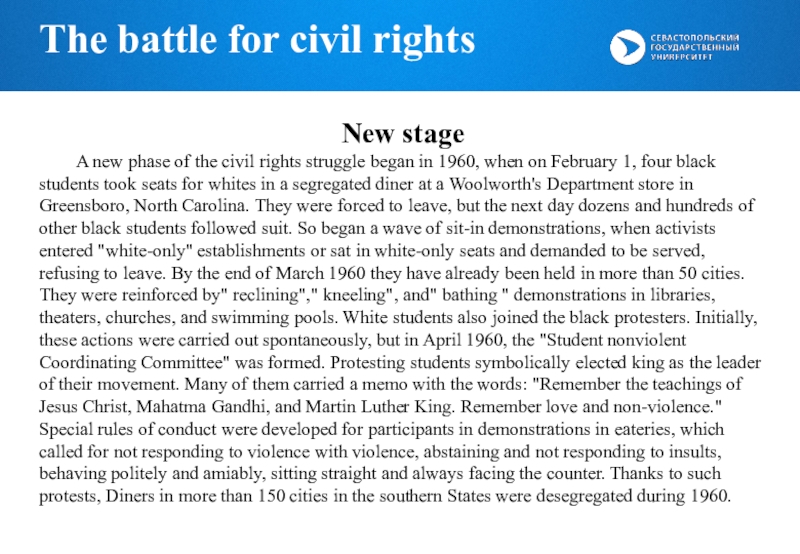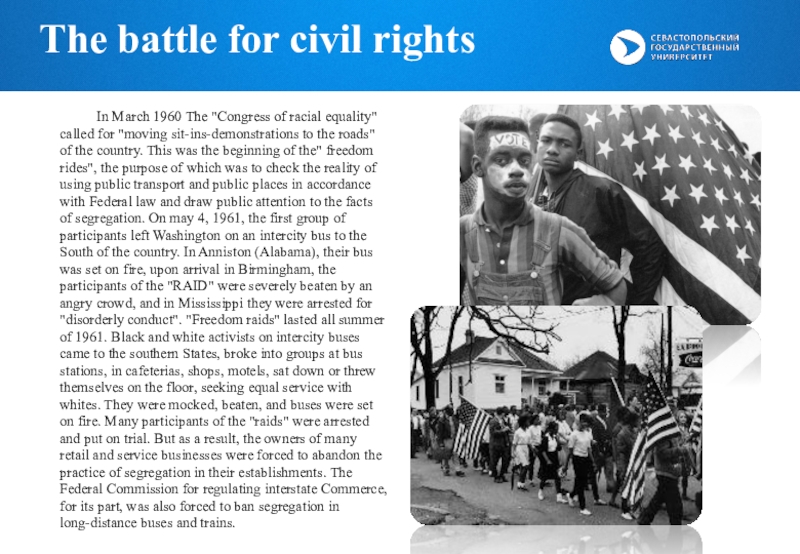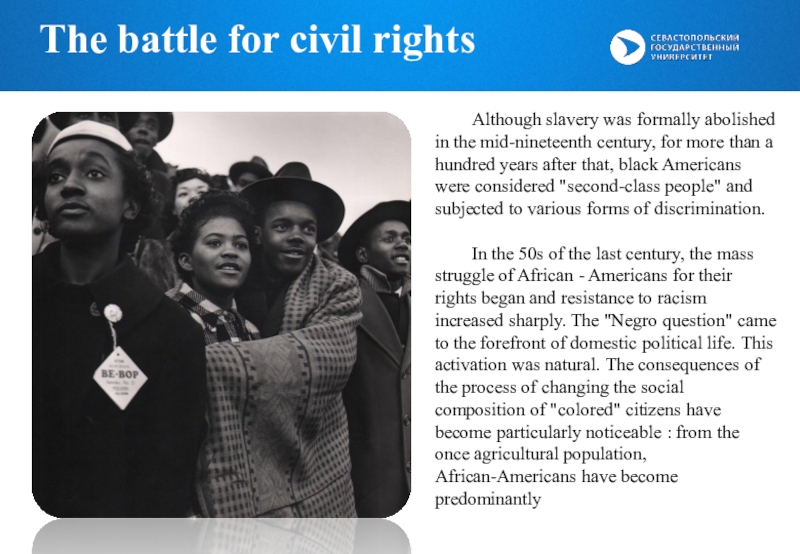Слайд 1The battle for civil rights
Докладчик
Студентка группы И/б-18-1-о
Янковенко Д.В.
Слайд 2The battle for civil rights
Although slavery was formally abolished in
the mid-nineteenth century, for more than a hundred years after
that, black Americans were considered "second-class people" and subjected to various forms of discrimination.
In the 50s of the last century, the mass struggle of African - Americans for their rights began and resistance to racism increased sharply. The "Negro question" came to the forefront of domestic political life. This activation was natural. The consequences of the process of changing the social composition of "colored" citizens have become particularly noticeable : from the once agricultural population, African-Americans have become predominantly
Слайд 3
The battle for civil rights
How did it all start?
December 1,
1955 Rosa Parks, a 42-year-old black seamstress at a Department
store in Montgomery, the capital of Alabama, was arrested and then fined for refusing to give up a seat on a bus to a white passenger, as required by local law. After the arrest of Rosa Parks, Ed Nixon, who headed the local Union of sleeping car conductors, called on the black community to boycott urban transport in protest. A boycott of bus lines in Montgomery was soon led by a young black priest, Martin Luther King. Thanks to the efforts of king and members of the boycott Committee, the protest of the black population lasted 381 days and went down in history as "Walking for freedom" - the protest participants had to walk to work and local bus companies suffered large losses.
Слайд 4The battle for civil rights
The leaders of the boycott filed
a lawsuit in Federal district court, which in December 1956
recognized the unconstitutionality of laws on segregation in city buses. Buses in Montgomery were integrated. But white supremacists started shooting at them. A black girl was severely beaten, a pregnant woman was shot in the leg, and bombs exploded in black neighborhoods. The violence stopped after it was strongly condemned by a local newspaper, a number of white priests, and a local business Association.
In 1957, a Federal court ordered integration in the municipal schools of little Rock, Arkansas. Nine black children were selected to enroll at little Rock Central high school, but the local police, by order of the state Governor, did not allow them to attend classes. After some hesitation, us President Dwight Eisenhower deployed soldiers from the 101st airborne division to enforce the court order. Soldiers accompanied the little Rock nine to school. When the children finally entered the Central school, they were met by an angry crowd who insulted them. A similar clash occurred in New Orleans in November 1960, when four black girls entered Franz elementary school in the Ninth district

Слайд 5The battle for civil rights
New stage
A new phase of the
civil rights struggle began in 1960, when on February 1,
four black students took seats for whites in a segregated diner at a Woolworth's Department store in Greensboro, North Carolina. They were forced to leave, but the next day dozens and hundreds of other black students followed suit. So began a wave of sit-in demonstrations, when activists entered "white-only" establishments or sat in white-only seats and demanded to be served, refusing to leave. By the end of March 1960 they have already been held in more than 50 cities. They were reinforced by" reclining"," kneeling", and" bathing " demonstrations in libraries, theaters, churches, and swimming pools. White students also joined the black protesters. Initially, these actions were carried out spontaneously, but in April 1960, the "Student nonviolent Coordinating Committee" was formed. Protesting students symbolically elected king as the leader of their movement. Many of them carried a memo with the words: "Remember the teachings of Jesus Christ, Mahatma Gandhi, and Martin Luther King. Remember love and non-violence." Special rules of conduct were developed for participants in demonstrations in eateries, which called for not responding to violence with violence, abstaining and not responding to insults, behaving politely and amiably, sitting straight and always facing the counter. Thanks to such protests, Diners in more than 150 cities in the southern States were desegregated during 1960.

Слайд 6The battle for civil rights
In March 1960 The "Congress of
racial equality" called for "moving sit-ins-demonstrations to the roads" of
the country. This was the beginning of the" freedom rides", the purpose of which was to check the reality of using public transport and public places in accordance with Federal law and draw public attention to the facts of segregation. On may 4, 1961, the first group of participants left Washington on an intercity bus to the South of the country. In Anniston (Alabama), their bus was set on fire, upon arrival in Birmingham, the participants of the "RAID" were severely beaten by an angry crowd, and in Mississippi they were arrested for "disorderly conduct". "Freedom raids" lasted all summer of 1961. Black and white activists on intercity buses came to the southern States, broke into groups at bus stations, in cafeterias, shops, motels, sat down or threw themselves on the floor, seeking equal service with whites. They were mocked, beaten, and buses were set on fire. Many participants of the "raids" were arrested and put on trial. But as a result, the owners of many retail and service businesses were forced to abandon the practice of segregation in their establishments. The Federal Commission for regulating interstate Commerce, for its part, was also forced to ban segregation in long-distance buses and trains.

Слайд 7The battle for civil rights
In 1962 The Supreme court of
the United States decided to enroll a black man, James
Meredith, at the University of Mississippi. However, this outcome was opposed by Mississippi Governor Ross Barnet and a racist part of the state's residents. Protesters gathered on campus. The resolution of the issue required the intervention of the Federal government in the person of President John F. Kennedy and attorney General Robert F. Kennedy. Kennedy. On September 30, James Meredith appeared at the University accompanied by Federal marshals, but several thousand Federal soldiers were sent to fully resolve the situation in Mississippi. During the riots, two people were killed, 375 people were injured and about 200 were arrested. A number of military personnel remained to guard Meredith until his release.
The racists resisted fiercely. In 1963 Alabama Governor George Wallace stated: "Segregation today, segregation tomorrow, segregation forever." On June 11, 1963, there was an incident at the entrance to the University when Wallace blocked the way for the first two black students of the University of Alabama — Vivian Malone and James Hood. On June 12, 1963, black activist Medgar Evers died on the doorstep of his home in Jackson, Mississippi, from a bullet from white racist Byron de La Beckwith..

Слайд 8The battle for civil rights
President Kennedy in June 1963 sent
a bill to Congress on broad desegregation and measures against
discrimination against black citizens. To put pressure on Congress, mass rallies and demonstrations were organized in many cities in the United States to demand the passage of this law. On August 28, 1963, a March on Washington was held, which was attended by 250 thousand people. This day has become a true celebration of the unity of whites and blacks.
July 2, 1964 President Johnson signed the civil rights Act of 1964, passed by Congress, which prohibited racial discrimination in trade, services, and employment. Martin Luther king, who was awarded the Nobel peace prize in October 1964, launched a campaign in the Alabama city of Selma to include blacks in the voter rolls. On March 7, 1965, participants in an unauthorized demonstration were severely beaten and 78 people were injured on the outskirts of Selma. Photos of this massacre were published by all the major Newspapers in the world.
Слайд 9The battle for civil rights
In the summer of 1967, spontaneous
black riots broke out in 128 cities, culminating in the
bloody riots in Newark and Detroit. To draw public attention to the situation in the black ghettos, the southern Christian leadership Conference moved its headquarters to Lowndale, a poor neighborhood of Chicago. Unions have been established tenants, defending the rights of local residents to "slumlords" owners of slum houses. According to many American researchers, king and his associates managed for a while to channel the spontaneous anger and destructive energy of the desperate poor from the black ghetto into organized nonviolent protest to solve specific problems.
In 1967, king put forward the idea of a "March of the poor" on Washington to demand the passage of the economic rights act, which was supposed to guarantee all poor Americans — black and white — a job and a living wage. In Washington, they were to set up a demonstrative tent city, block city highways, and stage sit-ins in govern
Слайд 10The battle for civil rights
The movement for black rights in
the United States was of tremendous importance, which cannot be
overestimated. In my opinion, it was after the acquisition of civil rights by a black person that the United States was able to fully integrate into the society of States devoid of racial prejudice.
Of course, the situation of blacks after the 70-ies of the XX century left much to be desired, but the situation was gradually corrected and now we can observe equality in all social areas of contacts of the inter-racial population of the United States. There is another striking trend that has become quite unexpected for me. Since the end of the 90s, there has been a so-called reverse segregation. This is expressed in the fact that, for example, the color of the skin when applying for a job in the United States again began to play a not yet important, but, nevertheless, a significant role. Now black citizens of the United States began to give more preference when hiring than their white compatriots






























